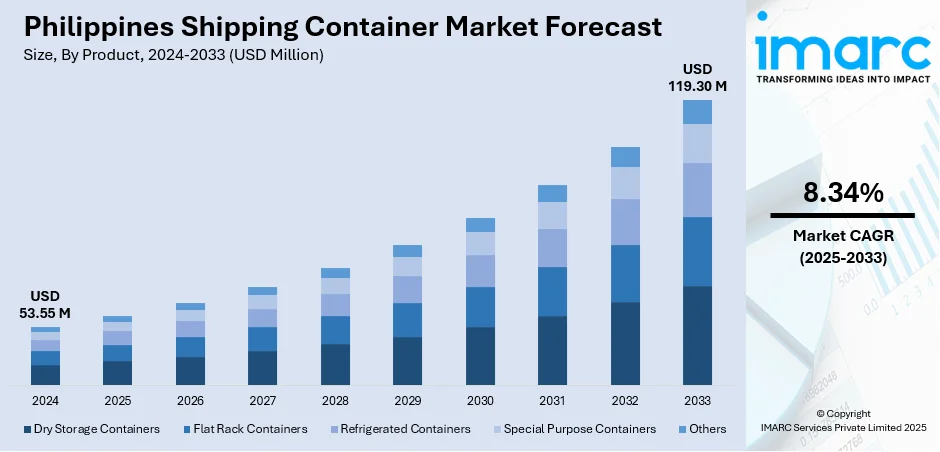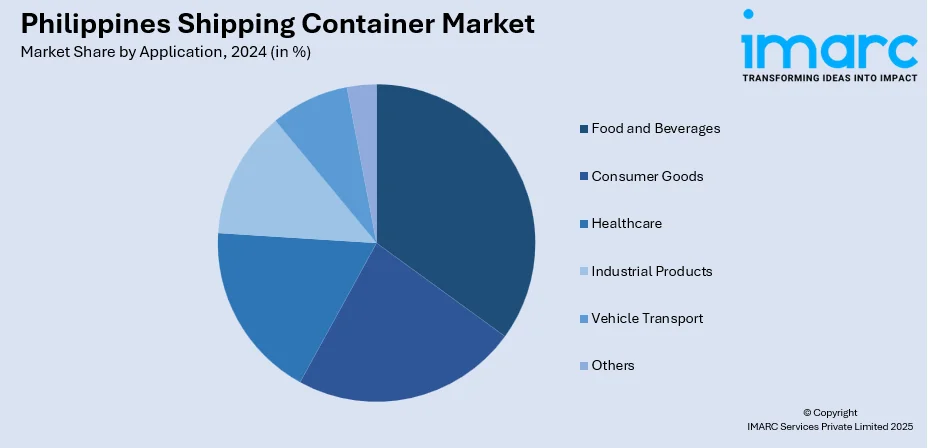
Philippines Shipping Container Market Size, Share, Trends and Forecast by Product, Container Size, Application, and Region, 2025-2033
Philippines Shipping Container Market Overview:
The Philippines shipping container market size reached USD 53.55 Million in 2024. Looking forward, the market is expected to reach USD 119.30 Million by 2033, exhibiting a growth rate (CAGR) of 8.34% during 2025-2033. The market is expanding due to increasing international trade, growing demand for secure logistics solutions, and rising use of containers in storage and intermodal transport. Infrastructure development and port modernization further support market growth. These factors collectively strengthen competitiveness and enhance the overall Philippines shipping container market share.
|
Report Attribute
|
Key Statistics
|
|---|---|
|
Base Year
|
2024
|
|
Forecast Years
|
2025-2033
|
|
Historical Years
|
2019-2024
|
| Market Size in 2024 | USD 53.55 Million |
| Market Forecast in 2033 | USD 119.30 Million |
| Market Growth Rate 2025-2033 | 8.34% |
Philippines Shipping Container Market Trends:
Expansion of International Trade and Export Activities
The continuous expansion of cross-border trade is one of the major forces pushing the market. With the nation consolidating its position as part of the global supply chain, there has been a significant increase in demand for standard and dependable containers. Major export commodities, such as produce, electronics, and manufactured products, need to be transported effectively and safely to foreign destinations. Shipping containers offer the toughness and safeguarding required for long-distance transport, maintaining product integrity and conformity with international standards. The growing role of the Philippines in regional and international trade agreements has further stimulated cross-border logistics, increasing the demand for containerized shipping. With increasing volumes of exports and diversified trading partners, the role of shipping containers continues to rise, fostering steady market growth.

To get more information on this market, Request Sample
Infrastructure Development and Port Modernization
Rapid improvements in infrastructure and port facilities are fueling the Philippines shipping container market growth. Government investments in upgrading seaports, expanding cargo handling capacities, and modernizing transport networks have enhanced logistics efficiency across the country. Modern terminals and enhanced intermodal connectivity between port facilities, trains, and road networks facilitate all cargo movement quicker, safer, and more economically. The developments relieve congestion, simplify customs procedures, and spur the increased use of containerized transportation of both imports and exports. Users of logistics hubs tend to incorporate shipping containers to enhance productivity within the hubs. In addition to boosting its internal economic activities, the country has aggressively invested in its infrastructure, and this has helped it to become a serious contender in the world maritime shipping trade.
Rising Demand for Intermodal and Storage Solutions
The growing reliance on intermodal transport and innovative storage solutions is another significant driver for the Philippines shipping container market. Containers are increasingly being used beyond maritime shipping, extending their role into rail, road, and inland logistics. Their versatility allows for smooth cargo transitions between modes of transport without repacking, saving time and reducing costs. Additionally, the use of shipping containers as temporary or permanent storage facilities for businesses, construction sites, and even modular housing solutions is expanding. Their durability, portability, and security make them an attractive choice for multiple industries. This rising adoption of containers across varied applications highlights their adaptability, ensuring consistent market demand while supporting both logistics efficiency and broader commercial uses in the Philippines.
Philippines Shipping Container Market Segmentation:
IMARC Group provides an analysis of the key trends in each segment of the market, along with forecasts at the country and regional levels for 2025-2033. Our report has categorized the market based on product, container size, and application.
Product Insights:
- Dry Storage Containers
- Flat Rack Containers
- Refrigerated Containers
- Special Purpose Containers
- Others
The report has provided a detailed breakup and analysis of the market based on the product. This includes the dry storage containers, flat rack containers, refrigerated containers, special purpose containers, and others.
Container Size Insights:
- Small Containers (20 feet)
- Large Containers (40 feet)
- High Cube Containers
- Others
A detailed breakup and analysis of the market based on the container size have also been provided in the report. This includes small containers (20 feet), large containers (40 feet), high cube containers, and others.
Application Insights:

- Food and Beverages
- Consumer Goods
- Healthcare
- Industrial Products
- Vehicle Transport
- Others
A detailed breakup and analysis of the market based on the application have also been provided in the report. This includes food and beverages, consumer goods, healthcare, industrial products, vehicle transport, and others.
Regional Insights:
- Luzon
- Visayas
- Mindanao
The report has also provided a comprehensive analysis of all the major regional markets, which include Luzon, Visayas, and Mindanao.
Competitive Landscape:
The market research report has also provided a comprehensive analysis of the competitive landscape. Competitive analysis such as market structure, key player positioning, top winning strategies, competitive dashboard, and company evaluation quadrant has been covered in the report. Also, detailed profiles of all major companies have been provided.
Philippines Shipping Container Market News:
- In July 2025, DP World, in collaboration with Asian Terminals Inc. (ATI), rolled out a fleet of 15 electric internal transfer vehicles (eITVs) at Manila South Harbour, marking the first deployment of its kind in the Philippines. To complement this initiative, the partners have also installed rapid-charging facilities designed to efficiently power the new vehicles.
- In September 2024, Loginno, a global leader in smart container solutions, introduced a groundbreaking pilot project in partnership with Iris Lines, a major domestic shipping operator in the Philippines. This initiative represents the first-ever deployment of smart container services within the country’s domestic shipping sector, setting a new milestone for the industry.
Philippines Shipping Container Market Report Coverage:
| Report Features | Details |
|---|---|
| Base Year of the Analysis | 2024 |
| Historical Period | 2019-2024 |
| Forecast Period | 2025-2033 |
| Units | Million USD |
| Scope of the Report |
Exploration of Historical Trends and Market Outlook, Industry Catalysts and Challenges, Segment-Wise Historical and Future Market Assessment:
|
| Products Covered | Dry Storage Containers, Flat Rack Containers, Refrigerated Containers, Special Purpose Containers, Others |
| Container Sizes Covered | Small Containers (20 feet), Large Containers (40 feet), High Cube Containers, Others |
| Applications Covered | Food and Beverages, Consumer Goods, Healthcare, Industrial Products, Vehicle Transport, Others |
| Regions Covered | Luzon, Visayas, Mindanao |
| Customization Scope | 10% Free Customization |
| Post-Sale Analyst Support | 10-12 Weeks |
| Delivery Format | PDF and Excel through Email (We can also provide the editable version of the report in PPT/Word format on special request) |
Key Questions Answered in This Report:
- How has the Philippines shipping container market performed so far and how will it perform in the coming years?
- What is the breakup of the Philippines shipping container market on the basis of product?
- What is the breakup of the Philippines shipping container market on the basis of container size?
- What is the breakup of the Philippines shipping container market on the basis of application?
- What is the breakup of the Philippines shipping container market on the basis of region?
- What are the various stages in the value chain of the Philippines shipping container market?
- What are the key driving factors and challenges in the Philippines shipping container market?
- What is the structure of the Philippines shipping container market and who are the key players?
- What is the degree of competition in the Philippines shipping container market?
Key Benefits for Stakeholders:
- IMARC’s industry report offers a comprehensive quantitative analysis of various market segments, historical and current market trends, market forecasts, and dynamics of the Philippines shipping container market from 2019-2033.
- The research report provides the latest information on the market drivers, challenges, and opportunities in the Philippines shipping container market.
- Porter's five forces analysis assist stakeholders in assessing the impact of new entrants, competitive rivalry, supplier power, buyer power, and the threat of substitution. It helps stakeholders to analyze the level of competition within the Philippines shipping container industry and its attractiveness.
- Competitive landscape allows stakeholders to understand their competitive environment and provides an insight into the current positions of key players in the market.
Need more help?
- Speak to our experienced analysts for insights on the current market scenarios.
- Include additional segments and countries to customize the report as per your requirement.
- Gain an unparalleled competitive advantage in your domain by understanding how to utilize the report and positively impacting your operations and revenue.
- For further assistance, please connect with our analysts.
 Request Customization
Request Customization
 Speak to an Analyst
Speak to an Analyst
 Request Brochure
Request Brochure
 Inquire Before Buying
Inquire Before Buying




.webp)




.webp)












